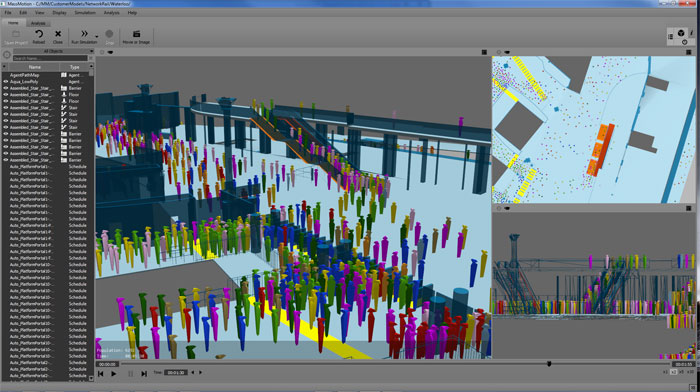AEC catches up with the latest updates to Oasys’ MassMotion software, which provides crowd flow simulation for buildings, transport and public spaces.
There have been a number of improvements to Oasys’ MassMotion crowd flow simulation software in its latest update.
Models can now be imported from CAD drawings or built from scratch. MassMotion supports all the popular CAD file formats. Tools enable import of 3D geometry from AutoCAD, SketchUp, MicroStation and Rhino as well as Industry Foundation Classes (IFC) models from Revit and ArchiCAD.
Portals have been added where individual agents spawn (origin) and exit (destinations) within the model, having negotiated floors, barriers, stairs and escalators.
Data is now stored in an external SQL database, speeding up overall simulation time.
There is enhanced agent scheduling, with the import of spreadsheet matrices. Using this method, Gatwick Airport analysed terminal usage by feeding in passenger numbers for flight arrivals.
‘Agents’ can be organised according to profiles, which define attributes such as speed, size, and tasks and colour coded to identify groups. There are many user definable characteristics that can be applied to agents from overall number to spawn rate. It’s also possible to see ‘vision maps’, indicating where agents are looking. Agents spawn and head to their destination and react to events in real-time, so should an escalator become overcrowded, they will seek an alternative route, the same if a gate should change from open to closed.
MassMotion can simulate the flow of hundreds of thousands of individual agents in real time as it is 64-bit and multi-threaded.
It is possible to run batch analysis for a variety of scenarios, but each case needs to be run several times to collate more accurate results.
Analysis
MassMotion’s analysis capabilities have been improved with much more graphical feedback within the model, as well as charting. This enables designers to quickly delve deeper into the simulation and clearly identify performance issues.
Journey time analysis between origins and destinations or across specific areas for individuals or groups is added. There is rapid feedback for flow rates on doors, stairs, escalators and user defined cordons. Problem areas can be identified, where queue lengths exceed thresholds or accumulate too great a number of agents. With colour co-ordinated density plots displayed in the 3D model, it is possible to identify varying ‘Levels of Service’ and bottleneck areas. All the simulations are recorded to the SQL database for playback.
Pricing
There is a range of options to get access to the software. The first stage is a 30-day free trial.
A full perpetual license is £20,000 but also requires a copy of Autodesk Softimage, at least for now. After the first year, an annual subscription for service and updates is 20% of the perpetual fee. Oasys aims to put out at least two updates a year. It is also possible to hire a MassMotion seat for one month (£3,060), three months (£6,120), six months (£9,180) and 12 months (£11,220). Discounts are available for multiple seats.
Conclusion
MassMotion is incredibly visual for a simulation tool. Major flow problems can be seen with queues and dense collections of agents backing up to negotiate a choke point in an evacuation scenario. The more subtle results can be found in the extensive reporting and charting, which can be sliced and diced in many ways. The visual aspect of the results belies the fact that the operator would still need to know what they were doing and interpret the results correctly, for which Oasys offers many online tutorials, as well as bespoke training.
The ability to mass load schedule data further benefits transport applications where flow is governed by regular arrivals and departures, as well as irregular events (i.e. ‘rush’ hour).
Historically, MassMotion was a plug-in to Autodesk’s Softimage visualisation software, where geometry was imported or created. MassMotion 6 requires a copy of SoftImage to author the geometry, but the runtime analysis now happens externally in an Oasys simulation environment. The workbench plug-in for SoftImage also now validates and automatically assigns properties of BIM geometry.
With Autodesk announcing the end of Softimage, Oasys is developing a replacement geometry environment, which should be released later this year.
If you enjoyed this article, subscribe to AEC Magazine for FREE






